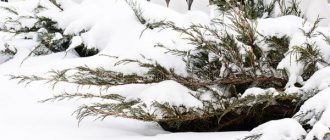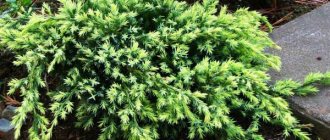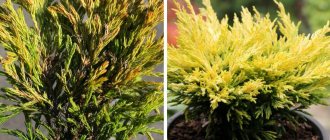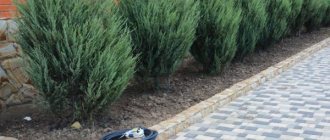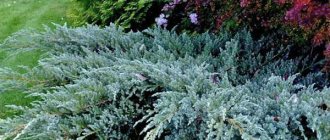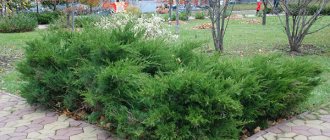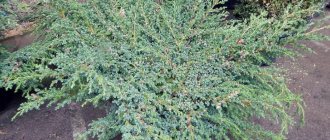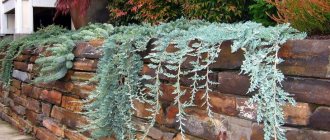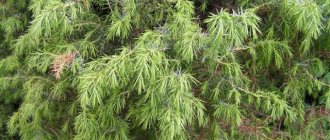» Bushes and trees » Crimean juniper: popular varieties
0
945
Article rating
Crimean juniper has a rich history. Back in the 15th century, it began to be used in Europe for cooking: mammalian meat fried on twigs and in juniper smoke acquired a special pine aroma and pleasant taste.
- How do they reproduce?
- Medicinal properties
- Contraindications
- Areas of application
- Reviews
Crimean juniper: popular varieties
The indigenous peoples of Crimea used this plant as an antiseptic - to this day, many local legends are associated specifically with the healing properties of this shrub. Time passes, but its role in everyday life has not lost its significance.
Presentation of Crimean junipers.
Let's consider the characteristic features of this variety. There are several of them.
These are quite ancient plants.
The word juniper comes from a pair of words, spruce and mozha.
Mozha means a strong knot.
Junipers were bred at the beginning of the nineteenth century in the Crimean Botanical Garden.
Now there is a fantastic number of species of Crimean junipers grown abroad.
Stories and photos of a larger number of species of Crimean juniper can be found on the Internet, just if you search.
Crimean juniper grows on the territory of the Crimean and Kerch peninsulas, as well as on the mountains that are part of the Krasnodar Territory.
This type of juniper tolerates heat well and is not sensitive to drought.
You can meet this type of juniper in mountainous areas no higher than one and a half kilometers above sea level.
Crimean juniper grows very slowly, by a couple of centimeters per year.
The average size in appearance is about four meters up.
Leaves, represented by thin needles, and well-groomed spruce needles.
Red berries can be found on the shoots.
They are inedible and poisonous, so they should never be eaten.
Important. Since the Crimean juniper is in the Red Book, cutting it down is strictly prohibited throughout the entire territory of Crimea and the federal city of Sevastopol.
The average age of the Crimean juniper is six hundred years.
After reaching the age of two hundred years, the bark begins to crack in parallel lines.
The needles change every five years.
The needles, which are already too old, fall off after some time, rot and create fertile soil for other plants and the juniper itself.
Flowering begins in early spring, the plants are very light-loving.
Where and how it grows, conditions
- In addition to Crimea, Crimean prickly juniper grows in South-Eastern and South-Western Europe, Western Asia, North Africa, the Caucasus, and south-west Russia.
- The natural growth zone of high juniper is the coast of the Mediterranean and Black Seas.
- Stinking juniper is very rare - only in the central basin of the Crimean Nature Reserve.
- The most common type is Cossack juniper. Juniper thickets can be found in the mountainous regions of the Caucasus, North America, in the Carpathians and Crimea, in the steppes of Siberia and Kazakhstan, in the Southern Urals, Altai, Western Sayan Mountains and so on.
- Common juniper is found in the mountains of North Africa, Crimea, Dagestan, and Southern Europe.
- All Crimean junipers are unpretentious: drought-resistant, not afraid of frost, soil-friendly, light-loving.
What types of Crimean junipers are there?
There are about six dozen varieties in total. There are five units of the main species of Crimean juniper. Let's list them: 1) Red, 2) Foul-smelling, 3) Cossack, 4) Standard, 5) Tree-like.
Of these five units of species, the creeping ones are the “stinker” and the Cossack; they are usually found on mountain slopes and resemble a carpet. These five units of juniper types are divided according to the type of needles. Creeping needles have hard needles, while erect needles are quite soft.
Where does it grow in nature?
Junipers are native to the northern hemisphere, but some species have a very limited range. Many of them can only tolerate subtropical climates. A subtropical zone passes through the southern part of the Crimean peninsula, and in this part you can find different types of junipers.
These evergreen conifers prefer full sun and are drought tolerant. Often, low-growing varieties grow on southern mountain slopes. Some species can be found in forest-steppe.
Red Crimean juniper.
Let us consider the distinctive features of this representative of this variety.
The first distinguishing feature of this variety.
This species has other names, for example, Spaniard or red cedar, and you can also find the name cedar heather.
The second distinctive feature of this variety.
The usual height for this variety is about eight meters.
The third distinctive feature of this variety.
It often happens that people call it thorn because the plant has very sharp needles.
The fourth distinctive feature of this variety.
The cone-covered bark is usually red.
The fifth distinguishing feature of this variety.
Flowering starts in September.
The sixth distinctive feature of this variety.
But cones do not exist on every juniper, these plants are dicotyledonous, that is, cones can only be on female plants, but not on male ones.
Types and varieties of plants, appearance
The Juniper genus includes about 70 species of the Cypress family, the Coniferous order, and the Gymnosperm class. Of all this diversity, only 5 species grow in Crimea: prickly juniper Juniperus oxycedrus, tall juniper Juniperus excelsa, stinking juniper Juniperus foetidissima Willd, Cossack juniper Juniperus sabina, common juniper, hemispherical Juniperus communis.
- Crimean prickly juniper (also called Spanish, red cedar, cedar heather, red) is a tree 4-6 m high with needle-shaped, very prickly needles. It is called red because of the pink color of the wood and brick-red cones. The plant of this species is dioecious, and cone berries appear only on female trees. Five subspecies of this plant have been bred: large-fruited juniper, chestnut juniper, red juniper, transtagan juniper, deltoid juniper.
- Tall juniper (tree-like) is perhaps the most famous species. The trees reach a height of 10 m and have a luxurious spreading crown. Young specimens, 2-2.5 m tall, have a cone-shaped crown. The needles are soft, bluish-green. The plant is monoecious; yellow male cones appear in April-March. When the cones open, the trees stand in a cloud of golden pollen. By autumn, green, bluish-colored cone berries appear, becoming almost black as they ripen.
- Juniper foul-smelling (foul-smelling) is not common. Outwardly similar to the tall Crimean juniper, its berries are larger in size and have the same unpleasant odor as the whole plant.
- Cossack Crimean juniper (photo of a juniper grove can be seen below) is a creeping shrub; there are 28 decorative forms of this species. Dioecious shrub one to one and a half meters high, with red-brown bark, needle-shaped, erect or soft scale-like needles. When rubbed, the needles and shoots emit a characteristic pungent odor. The cones are quite small - 5-7 mm, at first green in color, then become black-brown.
- Common juniper (short, appressed) is a creeping shrub up to 0.6 m in height, up to 2 m in diameter. The needles are dense and soft. The cone-shaped berries are 6-9 mm in size, green, then turn black.
Tall juniper.
Let us consider the distinctive features of this representative of this variety.
The first distinguishing feature of this variety.
This species has burgundy berries that are found along the main stem.
The second distinctive feature of this variety.
When reading descriptions of this variety, do not be surprised if it is described as showy or magnificent.
The third distinctive feature of this variety.
This variety attracts the attention of every person passing by.
The fourth distinctive feature of this variety.
This plant looks like a tree, unlike its fellows, which is what attracts the eye.
How to get there
The village of Novy Svet is located 7 km from Sudak.
Due to such a short distance, many vacationers travel this path on foot, enjoying the local beauty. If you want to get there in a breeze, take bus No. 5 in Sudak - it will take you to the village of Novy Svet in a few minutes. Do you have a car at your disposal? Move towards the Sudak fortress. Be careful as the road is very winding and unpredictable.
You can also get to the New World from Sudak by water by paying for a boat ride. You can also visit the Juniper Grove as part of a bus tour.
As already mentioned, a tour of the juniper grove in Crimea will be a real treat for the eyes. The lush greenery of the bushes and trees against the backdrop of the bright blue sky and gray rocks will allow you to take stunning photographs. Recommended angles:
- – The main tourist trail going into the distance;
- – Stone staircase of Tauris;
- – Sea panorama, taken from an elevated position, with juniper trees in the foreground;
- – View of Green Bay.
Look at the photos taken by tourists while visiting the juniper grove in the village of Novy Svet, and you will understand how wonderful it is there.
Foul-smelling Crimean juniper.
Let us consider the distinctive features of this representative of this variety.
The first distinguishing feature of this variety.
The cones of this variety are large and not burgundy, but black in color; the appearance of the juniper itself resembles the tree-like Crimean species.
The second distinctive feature of this variety.
The needles of this juniper also turn a little black.
The third distinctive feature of this variety.
The “smelly” juniper got its name precisely because its needles emit an unpleasant odor.
Indications for use
Before using juniper, you need to familiarize yourself with some indications. This plant can successfully cure diseases:
- Urinary system. Juniper is one of the most effective diuretics of plant origin. Various decoctions and infusions made from cones can be used to treat chronic inflammation of the kidneys, bladder, stones and sand in the kidneys, and severe edema. Decoctions are also used to treat dropsy and to disinfect the urinary tract.
- Gastrointestinal tract. The fruits of the bush are often used to treat indigestion. The berries of the bush can increase appetite, and at the same time normalize peristalsis, relieving heartburn. Experts recommend drinking decoctions based on the fruits of the plant for nausea, vomiting, and diarrhea. This remedy is also taken for diseases of the biliary tract and liver, and stomach diseases. It is worth noting that it is not necessary to make teas and decoctions based on juniper cones; they can simply be chewed raw.
- Nervous system. The shrub has a calming effect and relaxes the nervous system. Decoctions are recommended for use for constant insomnia, tripping and nervous disorders. It will also be very useful to lie before bed in a bath with the addition of needles from this plant.
- Organs of the respiratory system. The plant has the property of thinning phlegm, so it is recommended to be used for diseases of the bronchi and lungs. During periods of exacerbation of influenza and acute respiratory viral infections, the room can be fumigated with the smoke of juniper branches, as well as regularly organizing aromatherapy sessions based on the essential oils of this plant.
- Musculoskeletal system. Folk remedies based on coniferous shrubs are considered very effective for inflammation of joints, bones and muscles. It can be taken orally, and you can also use compresses and lotions based on the plant.
- Skin. The external remedy is used in the treatment of scabies, lichen, dermatitis, ulcers and many other skin diseases. The product is able to heal wounds and have a bactericidal effect. If your gums are inflamed, it is recommended to simply rinse your mouth with juniper decoctions. For otitis media, a tincture of conifer cones is instilled into the ears.
Not only the beneficial properties, but also the contraindications of juniper fruits must be studied before using it. This plant is strictly contraindicated in the presence of an acute inflammatory process in the kidneys and digestive organs. Under no circumstances should you use products based on this plant during pregnancy and lactation. The product is also contraindicated for use in children. In some cases, there may be individual intolerance of the body to the fruits of this shrub. If the dosage is not observed, a person may experience an allergic reaction or digestive upset.
Cossack juniper.
Let us consider the distinctive features of this representative of this variety.
The first distinguishing feature of this variety.
This is an ornamental plant that has soft needles.
The second distinctive feature of this variety.
As a rule, plants can be seen on mountain peaks, where they spread along the surface.
The third distinctive feature of this variety.
This is the most common shrub among junipers.
The fourth distinctive feature of this variety.
It can often be recognized in various garden plots, and in parks, as part of the edging composition, it is used in landscape design.
The fifth distinguishing feature of this variety.
This species has about three dozen varieties.
The sixth distinctive feature of this variety.
As a rule, the height does not exceed two hundred centimeters. The plant quickly increases in width.
The seventh distinctive feature of this variety.
The bark changes depending on the age of the plant.
The eighth distinguishing feature of this variety.
When young, the plants are very prickly, the needles are quite hard.
The ninth distinguishing feature of the true variety.
With age they soften and become very soft.
The tenth distinguishing feature of the present variety.
It is quite possible to meet this variety in Ukraine, Belarus, Kazakhstan and the Crimean Peninsula.
Medicinal properties
One of the main healing properties of juniper is its ability to disinfect any wounds, abrasions, and scratches. Therefore, in the old days it was used to fumigate the room where women in labor and the sick were located.
Juniper is used in medicine
This plant also has other healing abilities.
- Bactericidal. Bandages soaked in juniper oil or decoction are applied to areas affected by bacteria to destroy pathogenic microflora and quickly regenerate tissue.
- In America, all patients diagnosed with tuberculosis were moved to juniper forests for prevention and speedy healing.
- Dry fruits are set on fire and the room is fumigated with smoke to cleanse them of all viruses, bacteria and microbes.
- The phytoncides that this culture produces purify the air and have a beneficial effect on the human nervous system - it neutralizes irritability, neurosis, and increased excitability of the central nervous system.
- Patients noted other medicinal properties of juniper - eliminates headaches, insomnia, normalizes blood pressure, improves mood, strengthens the immune system.
According to traditional healers, healthy teas based on Crimean juniper berries improve the functioning of the kidneys and digestive tract.
Contraindications
Despite the presence of beneficial properties, there are several contraindications for use:
- pregnancy;
- peptic ulcer of the stomach, duodenum;
- individual intolerance;
- severe hypertension;
- kidney inflammation.
Common juniper growing in Crimea.
Let us consider the distinctive features of this representative of this variety.
The first distinguishing feature of this variety.
This species can be found throughout our country, in the north and in the temperate climate pole, mainly where there are forests.
The second distinctive feature of this variety.
The juniper is covered with small dry fruits.
The third distinctive feature of this variety.
Interesting. These fruits are used in the preparation of gin. And used as a seasoning.
The fourth distinctive feature of this variety.
It is important, do not forget that only the cones of the common juniper can be used as a tasty addition to dishes; Cossack, for example, is already poisonous to humans.
The fifth distinguishing feature of this variety.
It is not recommended to consume more than six units of fruit per day.
The sixth distinctive feature of this variety.
The crown of the plant resembles a pyramid or an egg. The crown is similar to a cypress and it is green.
Great juniper scent
I wanted to pay special attention to the smell of Cossack juniper. The shrub occupies one of the leading places in the abundance of bactericidal essential components.
It is no coincidence that our great-grandfathers believed that he was able to protect against dark forces. The branches of the plant were attached to the very ceiling of the house and hung in barns with livestock, so that they would protect them from misfortunes. Using the smoke of dried fruits, they fumigated and disinfected the clothes of sick people, and also expelled the bad smell from the home. If you plant this plant on your garden plot, then in ten years it can grow to an area of 20 m2, while forming dense, impenetrable thickets around it.
Cossack juniper belongs to the cypress plant family and has served as a symbol of eternal life for many nations and peoples. Also, this type of juniper has the following varieties: Femina, Jam, Mas, Rockery, etc. Let's figure out what is so valuable about this shrub.
Crimean juniper: how does it reproduce?
Most often, Crimean junipers are propagated using cuttings. If you carry out the procedure correctly, you can do it at almost any time of the year, preferably in the spring. The roots take root quite easily in the ground in the summer and then survive frosts well in the winter. There are a number of simple rules for the correct propagation of Crimean juniper. Let's look at a few recommendations for propagating this variety.
It is better to prepare cuttings when the weather is cloudy.
Sunlight directly hitting the sprouts can harm them.
Damage can be caused not only to small sprouts, but also to the plant that has a wound from the cut.
The best choice is already slightly woody shoots, which are located at the top of the bush.
Each variety of juniper has its own method of collecting cuttings.
It is recommended to cut off the upward-facing branches that are located at the top of the bush if you have a pyramidal juniper variety.
If you are the owner of creeping varieties, it is better to give preference to vertical branches.
If your juniper is bush-like, then you can use any shoots.
To cause the least harm to plants, it is better to use sharpened and disinfected tools.
It is necessary to remove excess needles on the lower five centimeters of the shoot.
They should be planted immediately, as cuttings cannot be stored.
The maximum shelf life of cuttings is one hundred and eighty minutes; they need to be placed in a container with water or it can be wrapped in a damp cloth and placed in a cool place.
But storing cuttings is not recommended; this can only be done if you have absolutely no time.
The ideal soil for planting is one that can allow liquid to pass through and that is sufficiently loose.
Well, peat or sand is suitable for this.
The above elements can be mixed in equal quantities.
Important. Crimean junipers love fairly acidic soil, so shells or ash added to the soil will help them grow better.
Planting should be done to a depth of three centimeters in already prepared boxes that contain the base of the soil.
The boxes should be placed in warm places with average air humidity.
It would be better not to place the boxes in direct sunlight, as they can cause burns to young plants.
At the beginning of plant germination, good watering is very important.
It is better to water with water that has been exposed to the sun.
To keep the humidity normal for young plants, you need to spray them with a spray bottle about six times a day.
Watering should be done only when the soil dries out.
The sprouts begin to hatch sixty days after planting.
It is recommended to keep the sprouts in a greenhouse for a year. If this cannot be done, then they should be replanted very carefully, together with the earthen lump that remains on the roots.
Rules of care
The main care of seedlings is to maintain stable heat and humidity at 70-75%. To do this, the plantings are irrigated daily with warm water at least 5 times a day.
They also provide protection from sunlight, which can cause severe burns, yellowing and death of young plants.
When kept on a southern windowsill, it is necessary to create shading with any fabric during the midday hours.
Junipers are watered as the soil dries out. If the soil has crusted over on top, it must be carefully loosened with a pencil or other thin object, avoiding injury to the cuttings.
The first buds on the seedlings will appear after 2-3 months of germination at home.
But you shouldn’t rush to plant them in an open area, because... they are still too weak and may die after transplantation. Ideally, plants are grown for another year at home or in a greenhouse and only moved into open ground in early autumn.
Where can Crimean juniper be used?
Let's consider several options for using this variety.
In ancient times, tableware was made from juniper wood. It was suitable for long-term storage of food and the food did not lose quality for me. When there were no refrigerators, this was certainly used.
In particular, there are not many junipers left in the Crimea, because they liked to make huts from them.
During the Russian Empire, sugar was often made from juniper berries.
Now, in the twenty-first century, anyone can buy juniper or cypress oil. It helps well in the fight against acute respiratory infections and acute respiratory viral infections, especially in winter, when it is so necessary,
To cleanse the respiratory system during illness, you can prepare a simple solution. You need to add two hundred milliliters of warm water to the evaporating device, mixed with five drops of oil from this beautiful plant.
People often make a tincture from fresh pine cones.
To make a tincture, you need to wash the cones well with distilled water, place them in two-liter jars and add three hundred grams of sugar. The tincture should be infused for fourteen to fifteen days in a dark place. After infusion, you need to add five hundred milliliters of alcohol. The tincture is ready.
On an industrial scale, cone berries are also used to make syrup for various candies and jellies.
Oil was also used to enhance the taste of fish in industry.
In ancient Rus', juniper resin was used as a lubricant to process strings in the musical field.
We've looked at how to use all parts of the juniper except the roots. The roots used to be used to make threads. Then they sewed strong sails for various ships, and also tied boards with them and used them for ship ropes.
Juniper: traditional treatment recipes
Cone berries are sold in the pharmacy chain. The raw materials are natural bactericidal, diuretic, and anti-inflammatory agents.
The most traditional method of treatment in folk medicine is to eat juniper fruits on an empty stomach.
It is important to follow the scheme: start with one berry and add one every day up to 15 pieces, then take it in the reverse order. Duration of treatment – month
As a result, cone berries improve blood composition, increase immunity, normalize metabolism, and relieve edema of cardiac origin.
Juniper oil
The oil is obtained by dry distillation of wood. The drug is sold in the pharmacy chain. The medicine is taken orally as a sedative, added to ointments, inhaled and massaged, and compresses are applied.
The oil is taken orally, drop by drop, twice a day, and diluted with water. Indications for use for nervous tension and insomnia. They also treat bronchitis and pneumonia, joint diseases.
The oil has proven itself in cosmetology for oily facial skin, getting rid of spurs and improving hair condition.
Important: drinking the pure product internally is strictly prohibited!
At home, you can prepare healing tea, decoction and tincture.
Simple ways to treat complex diseases:
Decoction
Used as a diuretic and choleretic drug. For external use, a more concentrated composition is made. The norm of raw materials is taken twice as much for the same amount of water. The decoction acts as a general tonic.
Required:
- 1 dec. l. fruits;
- 250 ml hot liquid.
How to do:
- Add water to the berries and cook for 5 minutes.
- After 40 minutes, strain, consume 2 tbsp. l. before meals.
Infusion
Required:
- 2 tbsp. l. fruits;
- 250 ml water.
How to do:
- Place the berries in a bowl and add hot liquid.
- After 2 hours, strain, consume 1 tbsp. l. before meals
Tincture recipes
The best medicine is juniper berry tincture. You can prepare the product yourself.
Vodka tincture
Required:
- 1 tbsp. l. fruits;
- 500 ml vodka.
How to cook:
- Grind the juniper berries, add vodka.
- Leave the product in a dark room for 14 days.
- Strain the tincture.
If you used moonshine for cooking, then additionally add one of the ingredients: sugar syrup, lemon zest, cinnamon.
Alcohol tincture
The recipe will require:
- 50 g juniper fruits;
- 500 ml alcohol.
Cooking instructions:
- Mash the fruits, add alcohol.
- Leave the composition for 10 days in a dark room.
- Then strain and pour into smaller containers.
Concentrated tincture recipe
Required:
- 1 tbsp. l. raw materials;
- 150 ml alcohol 70%.
Fill the cones with alcohol base and place in a warm room. After 7 days, filter.
Other recipes call for 20 parts alcohol base per portion of the berries.
The recommended dose is 15 drops before meals. Duration of treatment is 14-30 days.
The significant benefits of the tincture are manifested:
- for chronic pyelonephritis, cystitis, kidney stones, edema, infections of the urinary and genital organs;
- for the digestive system, improves the secretion of gastric juice and intestinal contraction, helps in the treatment of hemorrhoids, eliminates disgust, heartburn, flatulence, acts as a laxative, an effective medicine for treating the liver;
- for colds, promotes the release of phlegm from the lungs, relieves signs of sinusitis during aromatherapy;
- has a calming effect on the central nervous system and improves sleep quality;
- for the musculoskeletal system, relieves pain in polyarthritis, gout.
For external use, it is used to treat psoriasis, purulent wounds, bleeding gums, and heals ulcers.
Juniper is used as a flavoring for alcoholic drinks in Holland.
Juniper essential oil: properties and uses
Juniper essential oil contains terpenes, camphene, terpineol, tannins, borneol, macro and microelements, and organic acids. Essential oil has phytoncidal properties, that is, it is capable of purifying the air from pathogenic microorganisms. Therefore, it has been used for a long time to treat tuberculosis.
Effects that can be obtained through the use of juniper essential oil:
- Choleretic effect;
- Diuretic effect;
- Diaphoretic effect;
- Expectorant effect;
- Disinfecting effect;
- Regenerating effect;
- Calming effect.
Juniper essential oil is used to stimulate digestion, to enhance lymphatic drainage, and also as an antirheumatic agent.
Juniper essential oil is indicated for the following diseases:
- Cystitis;
- Joint diseases: arthritis, rheumatism, polyarthritis;
- Varicose veins;
- Gout;
- Dermatological diseases: psoriasis, dermatoses, lichen;
- Respiratory tract infections, including tuberculosis;
- Infections of the genitourinary system;
- Impotence;
- Diabetes;
- Allergy;
- Malaria;
- Atherosclerosis;
- Treatment of long-term non-healing wounds.
Juniper essential oil contains a high concentration of healing components and has a pungent odor. Therefore, it is often used in aromatherapy. The oil is poured into aroma lamps, they take baths with it and do inhalations. Such procedures effectively calm the nervous system, help normalize sleep, relieve stress and tension, and put you in a positive mood. Aromatherapy with juniper oil is an excellent procedure for the prevention of colds.
In addition, juniper essential oil is widely used in cosmetology. It has anti-cellulite properties, improves skin tone, and fights stretch marks. A few drops of juniper oil added to the night cream increase its disinfecting properties. Therefore, this product can be used by people prone to acne and acne.
You can add juniper oil to your day cream, which will improve your complexion, tighten pores, reduce swelling and additionally moisturize the dermis. A few drops of juniper oil will enrich any shampoo or hair conditioner. Regular use of this product will give your hair a natural shine, eliminate dryness and itching of the scalp, and prevent baldness.
You can add juniper oil to foot baths. This will help you get rid of calluses and corns faster. The skin of your feet will become soft and tender. In addition, it will be possible to obtain a powerful deodorizing effect, which is an excellent prevention of fungal diseases.
Use juniper essential oil as follows:
- 5 drops of oil are enough to enrich 10 g of any cosmetic product (mask, cream, shampoo, balm, etc.).
- 5 drops should be poured into an aroma lamp for aromatherapy.
- 3 drops are enough for instillation into an aroma pendant.
- 6 drops are enough for taking a bath with essential oil.
- 1 drop of oil is dissolved in 100 g of water for oral administration. You can pre-mix the oil with 1 teaspoon of honey.
Although juniper essential oil is very beneficial, you should consult your doctor before taking it internally. As for the external use of oil, you must first conduct an allergy test.
Skin and hair care
Crimean juniper is often used for hair and skin care. The essential oils of this plant have a profound effect on the hair follicles and epidermis (its deep layers). If you steam the branches and roots with boiling water, then this natural hair rinse will be as effective as possible.
It is enough to grind juniper berries with a blender and add it to masks to achieve ideal skin condition. This active component helps nourish the epidermis and also provides an optimal lifting effect. After the first use you will see the result.
